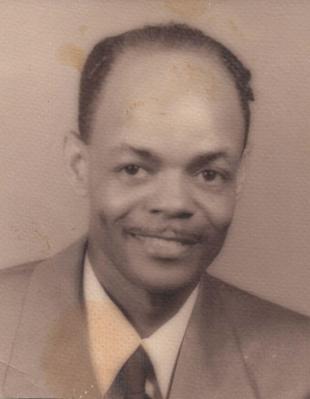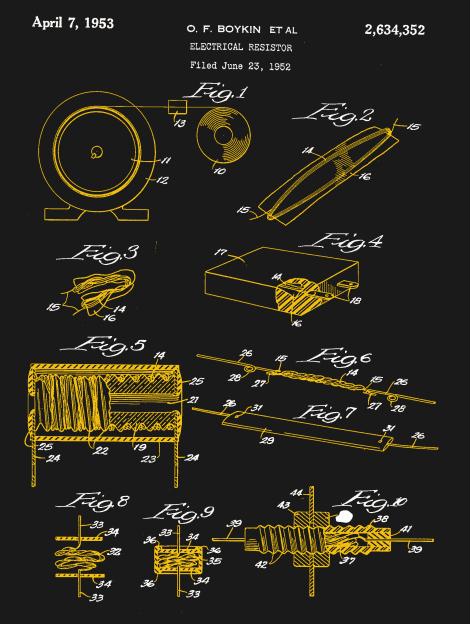The simplest ideas can be the ones that change the world. For Otis Boykin, it was a new way to make wirewound precision resistors. Just like that, he altered the course of electronics with his ideas about what a resistor could be. Now his inventions are in everything from household appliances and electronics to missile guidance computers.
While we like to geek out about developments in resistor tech, Otis’ most widely notable contribution to electronics is the control unit he designed for pacemakers, which regulate a person’s heartbeat. Pacemakers are a real-time clock for humans, and he made them more precise than ever.
Street Smarts and Book Smarts
Otis Frank Boykin was born August 29th, 1920 in Dallas, Texas to Sarah and Walter Boykin. Otis’ father was a carpenter who later became a preacher. His mother Sarah was a maid, and she died of heart failure when Otis was only a year old.

Not much is known about Otis’ childhood, but he must have had some foundational interest in electronics and the drive to go after a career in the field. We do know that Otis graduated as the valedictorian of Booker T. Washington high school in 1938. Then he moved to Nashville, Tennessee to attend Fisk University on a scholarship. As part of the deal, he worked as an assistant in the university’s aerospace lab, testing automatic controls for various aircraft.
Otis graduated from Fisk in 1941 and moved to Chicago to work as a lab assistant for Majestic Radio & TV. Before long, he was promoted to factory foreman. This position lasted a few years until he got hired as a research engineer at P.J. Nilson Labs in nearby Oak Park. During this time, he enrolled in the Illinois Institute of Technology. Otis only attended graduate school for two years — it’s unclear whether he dropped out because of financial problems, or he left because another job opportunity came along.
For the next fifteen years, Otis worked around Illinois and Indiana as a consultant in various radio and electronic positions. In 1946, Otis started a short-lived electronics research laboratory with one of his mentors, Hal Fruth, before the two were hired by the Monson Manufacturing Corporation.

Resistance is Utile
In the early 1950s, Otis invented a new, more precise type of wirewound resistor and applied for a patent. Wirewound resistors rely on coils of wire, and the loops introduce unwanted inductance to the circuit. Before Otis came along, wirewound resistors were difficult to make and thus quite expensive.
Otis’ wirewound resistors were made up of wire drawn out and wound into a skein. By twisting the ends of the skein and inserting thin sheets of plastic between the loops, Otis was able to minimize the resistors’ inductance and reactance. In the patent, he describes several variations on this theme with different types of housing and connectors.
A few years later, Otis patented another, even better resistor that was both cheap and easy to manufacture. It was tough enough to withstand extreme temperature changes and physical shocks without breaking or losing precision. This resistor was ideal for an array of applications. The US military used it in missile guidance computers, and IBM put it in their mainframes.

Setting the Pace for Life
He continued to pursue other inventions up until the end of his life. These included components like capacitors, a chemical air filter, and a burglar-proof cash register. But Otis Boykin’s most important invention was inspired by his mother’s death, and is currently keeping a large number of people’s hearts ticking accurately.
In 1964, he invented a control unit for pacemakers, which maintain a steady cadence for the human heart, regulating the heartbeat. Before this, pacemakers weren’t as reliable.
The sad irony is that Otis himself died of heart failure in 1982. His influence lives on in all the people who are alive because of his contributions to technology.















Today must be “Well written informative hackaday post day”. I hadn’t heard of Otis Boykin before. Thanks for bringing this unsung innovator to our attention. His inventions ended up in products that saved lives and those had the potential to end all life. That’s pretty awesome.
Every day is well-written, informative Hackaday post day!
My alma mater punches way above it’s weight for inventions!
since when?
Seeing the name Otis, I immediately thought of Elisha (https://en.wikipedia.org/wiki/Elisha_Otis) of the Otis Elevator Company. Thanks for letting me know about another great Otis.
Otis Redding!
B^)
Roger Smith’s most convincing persona yet.
What exactly do you mean by that?
Think carefully…
Dreadlocks wire resistors! Not into inductance. For all mankind.
Wilson Greatbatch invented the implantable pacemaker around 1960; tested it first in animals.
I had lunch with him 35 years ago when I worked for his sister company, Mennen Medical.
Today, at age 75, I have a Medtronic pacemaker keeping me alive.
Otis Boykin’s precision resistors were crucial to the success of implanted pacemakers.
I just got a Medtronic pacemaker a few months ago after developing nerve damage. As an embedded software engineer, I can now literally say embedded electronics are dear to my heart. I can also say that I’m bluetooth enabled, which is terrifying! It’s pretty amazing how will it works as a drop in replacement for my condition. Other than “aliasing” my ventricle beats above an upper rate limit, it keeps my heart pumping perfectly. I’m still relatively young, and will hopefully have many replacements over the years. I look forward to seeing the technology change over the decades.
My particular model has been previously recalled due to ceramic capacitors cracking and leading to premature battery depletion. Apparantly passive component reliability isn’t a completely solved problem, as they innovate on performance and features.